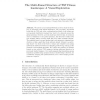Free Online Productivity Tools
i2Speak
i2Symbol
i2OCR
iTex2Img
iWeb2Print
iWeb2Shot
i2Type
iPdf2Split
iPdf2Merge
i2Bopomofo
i2Arabic
i2Style
i2Image
i2PDF
iLatex2Rtf
Sci2ools
AE
2015
Springer
2015
Springer
The Multi-Funnel Structure of TSP Fitness Landscapes: A Visual Exploration
Abstract. We use the Local Optima Network model to study the structure of symmetric TSP fitness landscapes. The ‘big-valley’ hypothesis holds that for TSP and other combinatorial problems, local optima are not randomly distributed, instead they tend to be clustered around the global optimum. However, a recent study has observed that, for solutions close in evaluation to the global optimum, this structure breaks down into multiple valleys, forming what has been called ‘multiple funnels’. The multiple funnel concept implies that local optima are organised into clusters, so that a particular local optimum largely belongs to a particular funnel. Our study is the first to extract and visualise local optima networks for TSP and is based on a sampling methodology relying on the Chained Lin-Kernighan algorithm. We confirm the existence of multiple funnels on two selected TSP instances, finding additional funnels in a previously studied instance. Our results suggests that transition...
| Added | 13 Apr 2016 |
| Updated | 13 Apr 2016 |
| Type | Journal |
| Year | 2015 |
| Where | AE |
| Authors | Gabriela Ochoa, Nadarajen Veerapen, Darrell Whitley, Edmund K. Burke |
Comments (0)

